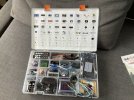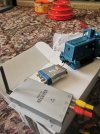I have some of the small component hook up boards bought from the sadly gone Maplin. I tend to do a test setup before committing to installation. By having the loco on my rolling road I will be able to test out the Bipolar led’s prior to installation.
You are using an out of date browser. It may not display this or other websites correctly.
You should upgrade or use an alternative browser.
You should upgrade or use an alternative browser.
What happened at your workbench today?
- Thread starter Henri
- Start date
DafyddElvy
1:22.5 & 15mm Scale Trams, , NG Steam Railways
Maplin are still around on-line, they just don't sell a lot of the useful things they did before.I have some of the small component hook up boards bought from the sadly gone Maplin. I tend to do a test setup before committing to installation. By having the loco on my rolling road I will be able to test out the Bipolar led’s prior to installation.
Oh big question, but it has all you need for setting up mini electrical projects some using the Elgeoo mini computer. There has been a thread on the other variation of this in the forum but forgot the name of the mini pc which is more commonly known. I used mine to make a flickering light that looks like a candle light when inside a paper wrapper. Here is the front iof the box. All sorts of sizes and prices on Amazon. Mine is a quite comprehensive kit that was around €30 when I bought it a couple of years back, but starter sets around €20 ish.Can you elaborate about this very interesting looking kit? Looks like one of these 'electronic' kits we had as kids!
Search on Amazon:-
elegoo project starter set
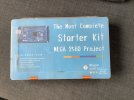
From checking Amazon "elegoo project starter set", I see it is Arduino compatible. I thought it all looked familiar! I use Arduinos for controlling DCC boosters, DCC control of CDU point controllers, and more recently, radio control for battery locos with Arduino/bluetooth controllers and Arduino/bluetooth receivers. I like the fact that there is so much hardware that is easily available for Arduinos. BTW here in Oz, we have Jaycar and Altronics - loads of electronic components available from many shops.Oh big question, but it has all you need for setting up mini electrical projects some using the Elgeoo mini computer. There has been a thread on the other variation of this in the forum but forgot the name of the mini pc which is more commonly known. I used mine to make a flickering light that looks like a candle light when inside a paper wrapper. Here is the front iof the box. All sorts of sizes and prices on Amazon. Mine is a quite comprehensive kit that was around €30 when I bought it a couple of years back, but starter sets around €20 ish.
Search on Amazon:-
elegoo project starter set
View attachment 303863
Yes that was what got me started Arduino. There was a lot on here about that that got me going.From checking Amazon "elegoo project starter set", I see it is Arduino compatible. I thought it all looked familiar! I use Arduinos for controlling DCC boosters, DCC control of CDU point controllers, and more recently, radio control for battery locos with Arduino/bluetooth controllers and Arduino/bluetooth receivers. I like the fact that there is so much hardware that is easily available for Arduinos. BTW here in Oz, we have Jaycar and Altronics - loads of electronic components available from many shops.
Last edited:
This evening I screwed up my courage and opened up my LGB ABe4/4 Bernina railcar for the fourth time. This time to install a reed switch I had ordered for it about a year ago. Previous adventures with this loco during the roughly 20 years I've had it were to install extra passengers, then replacing passengers that didn't want to stay seated and finally about six years ago, installing a Massoth XLS On-board sound decoder in place of the original MZS non-sound driving decoder. I actually got it back together without breaking anything having remembered all the tricks for this loco! . A quick test and everything still works including the newly installed reed switch that triggers the whistle.
. A quick test and everything still works including the newly installed reed switch that triggers the whistle. I should never have to open it up again after this final upgrade! I also did a little painting of some details while I had it on the workbench.
I should never have to open it up again after this final upgrade! I also did a little painting of some details while I had it on the workbench.
Last edited:
Windym87
Registered
it’s been all about wagons on my workbench recently.
Two of my original toy train wagons have been repainted, the box van originally was repainted blue, however now
is as close to DR Brown as I can get for the moment and matches the Open.
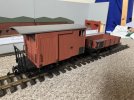
three cheapo eBay purchases I’ve also been on the workbench the DR Grey flat needing a good clean with some IPA and the larger Brown open had a rather large block of wood inside covered in coal, this was removed and eventually will have some sort of better load fitted. Last but not least the small DR open wagon was missing any sort of buffers so these have been reinstated although I’m on the lookout for two buffer heads
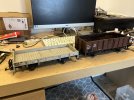
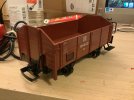
Two of my original toy train wagons have been repainted, the box van originally was repainted blue, however now
is as close to DR Brown as I can get for the moment and matches the Open.

three cheapo eBay purchases I’ve also been on the workbench the DR Grey flat needing a good clean with some IPA and the larger Brown open had a rather large block of wood inside covered in coal, this was removed and eventually will have some sort of better load fitted. Last but not least the small DR open wagon was missing any sort of buffers so these have been reinstated although I’m on the lookout for two buffer heads


Chop a couple out of plasticard, drill for a small nail to this and the shank to help hold while glueing in place. Painted black nail almost invisible.it’s been all about wagons on my workbench recently.
Two of my original toy train wagons have been repainted, the box van originally was repainted blue, however now
is as close to DR Brown as I can get for the moment and matches the Open.
View attachment 304022
three cheapo eBay purchases I’ve also been on the workbench the DR Grey flat needing a good clean with some IPA and the larger Brown open had a rather large block of wood inside covered in coal, this was removed and eventually will have some sort of better load fitted. Last but not least the small DR open wagon was missing any sort of buffers so these have been reinstated although I’m on the lookout for two buffer heads
View attachment 304023
View attachment 304024
a98087
Registered
it’s been all about wagons on my workbench recently.
Two of my original toy train wagons have been repainted, the box van originally was repainted blue, however now
is as close to DR Brown as I can get for the moment and matches the Open.
View attachment 304022
three cheapo eBay purchases I’ve also been on the workbench the DR Grey flat needing a good clean with some IPA and the larger Brown open had a rather large block of wood inside covered in coal, this was removed and eventually will have some sort of better load fitted. Last but not least the small DR open wagon was missing any sort of buffers so these have been reinstated although I’m on the lookout for two buffer heads
View attachment 304023
View attachment 304024
Looks good!
Was it an off the shelf colour? Or your own mix?
Dan
Windym87
Registered
It’s a Railmatch acrylic pot of Dark Rust.Looks good!
Was it an off the shelf colour? Or your own mix?
Dan
David1226
Registered
Just completed my latest, and last, coach build for the Claptowte Railway, brake/third No 3. Although the Claptowte Railway passenger coach fleet is numbered 1- 18, there are only seventeen of them. Right from the start of constructing them, it has always been the premise that coach No 3, the twin of coach No 4, has been taken out of passenger revenue service, converted into a tool/mess van and re-liveried in Engineering Department green, to accompany the department's travelling crane. To that end the passenger compartment has been fitted with tables for the work crew.
As with coach No 4, this model has been created by grafting together a LGB Toy Train 4-wheel coach and a balcony ended van, an exercise more complex than it sounds, due to differences in the height of the body sides and the roof profiles. I have just put the model through the photo studio, in the raw. I now have to dismantle it so that it can be primed and painted.
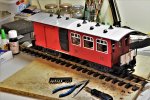
David
As with coach No 4, this model has been created by grafting together a LGB Toy Train 4-wheel coach and a balcony ended van, an exercise more complex than it sounds, due to differences in the height of the body sides and the roof profiles. I have just put the model through the photo studio, in the raw. I now have to dismantle it so that it can be primed and painted.

David
Flying15
Registered
Hi DavidJust completed my latest, and last, coach build for the Claptowte Railway, brake/third No 3. Although the Claptowte Railway passenger coach fleet is numbered 1- 18, there are only seventeen of them. Right from the start of constructing them, it has always been the premise that coach No 3, the twin of coach No 4, has been taken out of passenger revenue service, converted into a tool/mess van and re-liveried in Engineering Department green, to accompany the department's travelling crane. To that end the passenger compartment has been fitted with tables for the work crew.
As with coach No 4, this model has been created by grafting together a LGB Toy Train 4-wheel coach and a balcony ended van, an exercise more complex than it sounds, due to differences in the height of the body sides and the roof profiles. I have just put the model through the photo studio, in the raw. I now have to dismantle it so that it can be primed and painted.
View attachment 304149
David
Could you tell us a bit more about the build includi g the bogies and underframe as well as coupling set up
Thanks
Oh yes, I think we've all heard that beforeJust completed my latest, and last,
David1226
Registered
Once the model has been painted, finished and photographed, as with all my other models, I will do a full stage by stage write up on how the model was constructed.Hi David
Could you tell us a bit more about the build includi g the bogies and underframe as well as coupling set up
Thanks
Coach No 4, twin of the new build No 3.
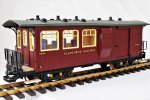
David
Monifieth Stuart
Registered
As a newcomer who can barely get wee trains to go round without derailing, I am always amazed at the back stories people like yourself have for aspects of your railways. And then you take apart carefully manufactured products and create even more amazing wagons. carriages and locomotives. Inspiring!Just completed my latest, and last, coach build for the Claptowte Railway, brake/third No 3. Although the Claptowte Railway passenger coach fleet is numbered 1- 18, there are only seventeen of them. Right from the start of constructing them, it has always been the premise that coach No 3, the twin of coach No 4, has been taken out of passenger revenue service, converted into a tool/mess van and re-liveried in Engineering Department green, to accompany the department's travelling crane. To that end the passenger compartment has been fitted with tables for the work crew.
As with coach No 4, this model has been created by grafting together a LGB Toy Train 4-wheel coach and a balcony ended van, an exercise more complex than it sounds, due to differences in the height of the body sides and the roof profiles. I have just put the model through the photo studio, in the raw. I now have to dismantle it so that it can be primed and painted.
View attachment 304149
David
David1226
Registered
If you like 'back stories', I think it is not unreasonable to re-post the history of the Claptowte Railway, for newer Forum Members who may not be aware. It may give you an insight into my weird world.As a newcomer who can barely get wee trains to go round without derailing, I am always amazed at the back stories people like yourself have for aspects of your railways. And then you take apart carefully manufactured products and create even more amazing wagons. carriages and locomotives. Inspiring!
The Claptowte Railway – The History
The Claptowte Railway is a British narrow gauge line, set somewhere in the English - Welsh border country, sometime around the last half of the 20th century. The line meanders through the Vale of Claptowte from an exchange with a main line standard gauge railway, at Ellceware, up to the head of the valley and the rural terminus at Welwawn. The line is often incorrectly referred to as the Welwawn and Claptowte Railway, or, The Old W.C.
Gernise End is an intermediate station, with a run around loop that enables passenger and goods trains to pass each other, near to the head of the valley. It is a busy stopping off place for the grouse moors and long distance footpaths of the upper reaches of the vale. It has basic goods handling facilities comprising a loading dock, a cattle dock and a yard crane. There are also coal staithes operated by the local coal merchant, I.P.Black.
The Motive Power Depot, workshop facilities and carriage sidings are located along the line at Phidell Yard
Since the dawn of the Industrial Revolution, a number of small independent engineering machine shops, dotted about the vale, have specialised in, and become renowned for, the manufacture of watnaims, in fact, Claptowte watnaims are known to Mechanical Engineers all over the world. There cannot be many engineering installations around the former British Empire not fitted with a Claptowte watnaim. Goudes Sidings, located just outside Gernise End, was once the bustling hub of this trade, handling incoming raw materials and the export of the finished products. With the introduction of modern technology, this local industry is now very much in decline, except of course for the demand for spare parts. Engineering students come from far and wide to study the few remaining machine shops that are now regarded as living museums.
The subsequent decline in production means that Goudes Sidings is now used only as a stabling point for the line’s Engineering Department and their travelling crane can usually be seen parked there.
In order to avoid the considerable Civil Engineering costs, and difficulties, that would have been required to push a standard gauge railway through the undulating and twisting topography of the vale, the founding fathers of the line elected to construct a narrow gauge railway that would follow the contours of the vale, rather than combat them. They sought out and engaged an acknowledged narrow gauge expert of the day, Ivor Biggedd, to be the company’s first Chief Mechanical Engineer.
Prior to taking up this appointment, Biggedd had undertaken an extensive tour of Europe in order to study Continental railway practices. He was deeply impressed by the ride quality and generous loading gauge of European metre gauge (3’ 3’’) railways when compared to the almost universal two foot gauge (60cm) and restricted clearances of most British narrow gauge lines. He attributed this to the fact that most British narrow gauge lines had evolved from industrial horse-drawn tramways. Given a blank piece of paper Biggedd proposed, from the outset, to construct a metre gauge railway. His many close links with various European railway companies and manufacturers meant that he was able to purchase continental locomotives and stock at very advantageous prices, a factor that greatly endeared him to the Board of Directors, under the Chairmanship of Sir Nial DeMencha.
The European links have been maintained with the more recent introductions of diesel power. Over the years, a succession of rebuilds and modifications, in the company’s own workshop, has greatly altered the appearance of much of the stock from its European origins. This, together with its metre gauge, has given the Claptowte Railway its unique character.
The first arrival of the day, at Gernise End, brings newspapers, parcels and mail up from Elceware. At Welwawn, a pair of milk vans are coupled to the train, for the return trip, as milk, in churns, is still collected from various stops along the line, for delivery to the dairy at Ellceware. Livestock, poultry, vegetables and other local produce are transported to and from the weekly market at Welwawn. Coal and coke are delivered to the fires and cooking ranges of Gernise End where the tentacles of the gas main have yet to reach. The few narrow, winding roads of the vale, hemmed in by high dry stone walls, or hedges, have kept motor transport to a minimum and the railway is still the prime mover of freight and passengers, in the area.
The principle shareholder of the line is also the largest landowner in the area, Lord Ellpasse. The Ellpasse Estates cover large swathes of the vale, including the extensive grouse moors above Gernies End. Lord Ellpasse welcomed the building of the railway as a means of conveniently and comfortably bringing paying guests to his shooting parties on the moors. Estate workers are sent, in the shooting brake, to meet and greet the guests at the station. They can frequently be heard roaming the platform calling out their employer’s name, Lord Ellpasse. These cries often bring the local vicar, Rev W.Awdry, who has himself more than a passing interest in railways, running to see what is amiss.
Unfortunately, these days, Lord Elpasse is more famous following the notorious scandal surrounding him and his Children’s Nanny, Honour Bakke. Among the passengers arriving at Gernise End there are a new breed of animal, the Investigative Journalist. These have been known to trawl the inns and hostelries of the Vale attempting to illicit any sordid details from the locals by plying them with drink. Given that Lord Ellpasse is the largest employer and landlord in the area, the locals are understandably tight lipped.
The end of post World War II austerity has seen a gradual return to the area of Homo Touristus. They are returning in ever increasing numbers, armed with a Thermos flask and an illustrated copy of A.Wainwright’s ‘Walking the Claptowte Way’’, to explore the beautiful countryside around the Vale. Another attraction, for many, is the locally brewed ale, which is savoured by many who end up spending time on The Old W.C.
The rapid demise of steam locomotion on national standard gauge services is leading to a growing interest, by enthusiasts, in preserving independent steam operated narrow gauge railways. All of the above factors means that passenger schedules are well patronised, whatever the time of year, and the line’s future seems assured.
And yes . . . if you have not already worked it out, Gernise End is pronounced Journey’s End. What better name for the culmination of a lifetime of modelling?
David Goldsworthy
Chief Mechanical Engineer
The Claptowte Railway
Last edited:
DafyddElvy
1:22.5 & 15mm Scale Trams, , NG Steam Railways
That is excellent sir, thanks for re-sharingIf you like 'back stories', I think it is not unreasonable to re-post the history of the Claptowte Railway, for newer Forum Members who may not be aware. It may give you an insight into my weird world.
The Claptowte Railway – The History
The Claptowte Railway is a British narrow gauge line, set somewhere in the English - Welsh border country, sometime around the last half of the 20th century. The line meanders through the Vale of Claptowte from an exchange with a main line standard gauge railway, at Ellceware, up to the head of the valley and the rural terminus at Welwawn. The line is often incorrectly referred to as the Welwawn and Claptowte Railway, or, The Old W.C.
Gernise End is an intermediate station, with a run around loop that enables passenger and goods trains to pass each other, near to the head of the valley. It is a busy stopping off place for the grouse moors and long distance footpaths of the upper reaches of the vale. It has basic goods handling facilities comprising a loading dock, a cattle dock and a yard crane. There are also coal staithes operated by the local coal merchant, I.P.Black.
The Motive Power Depot, workshop facilities and carriage sidings are located along the line at Phidell Yard
Since the dawn of the Industrial Revolution, a number of small independent engineering machine shops, dotted about the vale, have specialised in, and become renowned for, the manufacture of watnaims, in fact, Claptowte watnaims are known to Mechanical Engineers all over the world. There cannot be many engineering installations around the former British Empire not fitted with a Claptowte watnaim. Goudes Sidings, located just outside Gernise End, was once the bustling hub of this trade, handling incoming raw materials and the export of the finished products. With the introduction of modern technology, this local industry is now very much in decline, except of course for the demand for spare parts. Engineering students come from far and wide to study the few remaining machine shops that are now regarded as living museums.
The subsequent decline in production means that Goudes Sidings is now used only as a stabling point for the line’s Engineering Department and their travelling crane can usually be seen parked there.
In order to avoid the considerable Civil Engineering costs, and difficulties, that would have been required to push a standard gauge railway through the undulating and twisting topography of the vale, the founding fathers of the line elected to construct a narrow gauge railway that would follow the contours of the vale, rather than combat them. They sought out and engaged an acknowledged narrow gauge expert of the day, Ivor Biggedd, to be the company’s first Chief Mechanical Engineer.
Prior to taking up this appointment, Biggedd had undertaken an extensive tour of Europe in order to study Continental railway practices. He was deeply impressed by the ride quality and generous loading gauge of European metre gauge (3’ 3’’) railways when compared to the almost universal two foot gauge (60cm) and restricted clearances of most British narrow gauge lines. He attributed this to the fact that most British narrow gauge lines had evolved from industrial horse-drawn tramways. Given a blank piece of paper Biggedd proposed, from the outset, to construct a metre gauge railway. His many close links with various European railway companies and manufacturers meant that he was able to purchase continental locomotives and stock at very advantageous prices, a factor that greatly endeared him to the Board of Directors, under the Chairmanship of Sir Nial DeMencha.
The European links have been maintained with the more recent introductions of diesel power. Over the years, a succession of rebuilds and modifications, in the company’s own workshop, has greatly altered the appearance of much of the stock from its European origins. This, together with its metre gauge, has given the Claptowte Railway its unique character.
The first arrival of the day, at Gernise End, brings newspapers, parcels and mail up from Elceware. At Welwawn, a pair of milk vans are coupled to the train, for the return trip, as milk, in churns, is still collected from various stops along the line, for delivery to the dairy at Ellceware. Livestock, poultry, vegetables and other local produce are transported to and from the weekly market at Welwawn. Coal and coke are delivered to the fires and cooking ranges of Gernise End where the tentacles of the gas main have yet to reach. The few narrow, winding roads of the vale, hemmed in by high dry stone walls, or hedges, have kept motor transport to a minimum and the railway is still the prime mover of freight and passengers, in the area.
The principle shareholder of the line is also the largest landowner in the area, Lord Ellpasse. The Ellpasse Estates cover large swathes of the vale, including the extensive grouse moors above Gernies End. Lord Ellpasse welcomed the building of the railway as a means of conveniently and comfortably bringing paying guests to his shooting parties on the moors. Estate workers are sent, in the shooting brake, to meet and greet the guests at the station. They can frequently be heard roaming the platform calling out their employer’s name, Lord Ellpasse. These cries often bring the local vicar, Rev W.Awdry, who has himself more than a passing interest in railways, running to see what is amiss.
Unfortunately, these days, Lord Elpasse is more famous following the notorious scandal surrounding him and his Children’s Nanny, Honour Bakke. Among the passengers arriving at Gernise End there are a new breed of animal, the Investigative Journalist. These have been known to trawl the inns and hostelries of the Vale attempting to illicit any sordid details from the locals by plying them with drink. Given that Lord Ellpasse is the largest employer and landlord in the area, the locals are understandably tight lipped.
The end of post World War II austerity has seen a gradual return to the area of Homo Touristus. They are returning in ever increasing numbers, armed with a Thermos flask and an illustrated copy of A.Wainwright’s ‘Walking the Claptowte Way’’, to explore the beautiful countryside around the Vale. Another attraction, for many, is the locally brewed ale, which is savoured by many who end up spending time on The Old W.C.
The rapid demise of steam locomotion on national standard gauge services is leading to a growing interest, by enthusiasts, in preserving independent steam operated narrow gauge railways. All of the above factors means that passenger schedules are well patronised, whatever the time of year, and the line’s future seems assured.
And yes . . . if you have not already worked it out, Gernise End is pronounced Journey’s End. What better name for the culmination of a lifetime of modelling?
David Goldsworthy
Chief Mechanical Engineer
The Claptowte Railway

